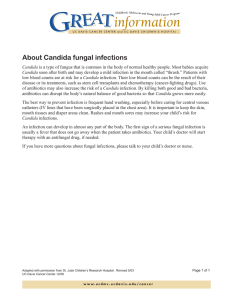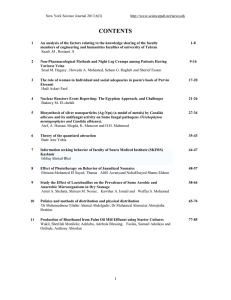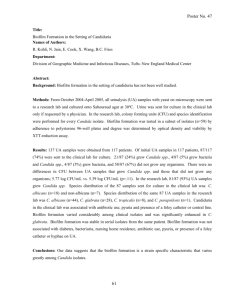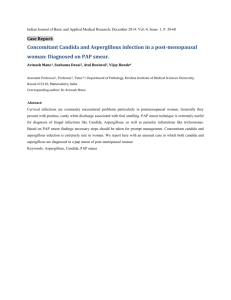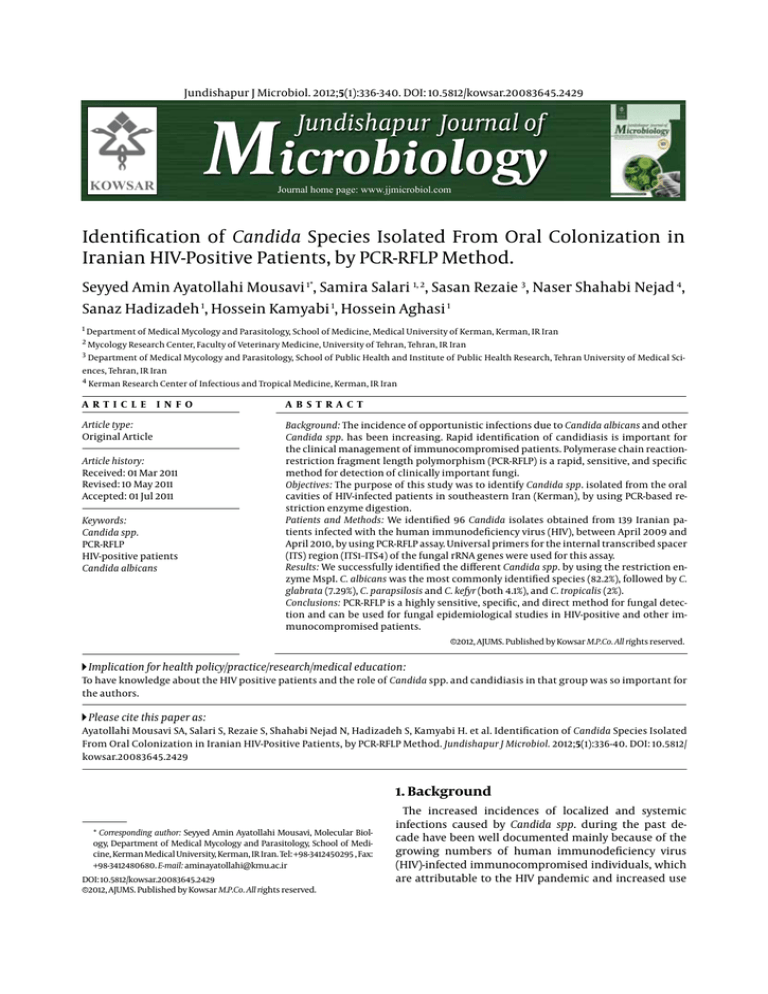
Jundishapur J Microbiol. 2012;5(1):336-340. DOI: 10.5812/kowsar.20083645.2429
Microbiology
Jundishapur Journal of
KOWSAR
Journal home page: www.jjmicrobiol.com
Identification of Candida Species Isolated From Oral Colonization in
Iranian HIV-Positive Patients, by PCR-RFLP Method.
Seyyed Amin Ayatollahi Mousavi 1*, Samira Salari 1, 2, Sasan Rezaie 3, Naser Shahabi Nejad 4,
Sanaz Hadizadeh 1, Hossein Kamyabi 1, Hossein Aghasi 1
1 Department of Medical Mycology and Parasitology, School of Medicine, Medical University of Kerman, Kerman, IR Iran
2 Mycology Research Center, Faculty of Veterinary Medicine, University of Tehran, Tehran, IR Iran
3 Department of Medical Mycology and Parasitology, School of Public Health and Institute of Public Health Research, Tehran University of Medical Sci-
ences, Tehran, IR Iran
4 Kerman Research Center of Infectious and Tropical Medicine, Kerman, IR Iran
AR T I C LE
I NFO
Article type:
Original Article
Article history:
Received: 01 Mar 2011
Revised: 10 May 2011
Accepted: 01 Jul 2011
Keywords:
Candida spp.
PCR-RFLP
HIV-positive patients
Candida albicans
AB S TRAC T
Background: The incidence of opportunistic infections due to Candida albicans and other
Candida spp. has been increasing. Rapid identification of candidiasis is important for
the clinical management of immunocompromised patients. Polymerase chain reactionrestriction fragment length polymorphism (PCR-RFLP) is a rapid, sensitive, and specific
method for detection of clinically important fungi.
Objectives: The purpose of this study was to identify Candida spp. isolated from the oral
cavities of HIV-infected patients in southeastern Iran (Kerman), by using PCR-based restriction enzyme digestion.
Patients and Methods: We identified 96 Candida isolates obtained from 139 Iranian patients infected with the human immunodeficiency virus (HIV), between April 2009 and
April 2010, by using PCR-RFLP assay. Universal primers for the internal transcribed spacer
(ITS) region (ITS1–ITS4) of the fungal rRNA genes were used for this assay.
Results: We successfully identified the different Candida spp. by using the restriction enzyme MspI. C. albicans was the most commonly identified species (82.2%), followed by C.
glabrata (7.29%), C. parapsilosis and C. kefyr (both 4.1%), and C. tropicalis (2%).
Conclusions: PCR-RFLP is a highly sensitive, specific, and direct method for fungal detection and can be used for fungal epidemiological studies in HIV-positive and other immunocompromised patients.
c 2012, AJUMS. Published by Kowsar M.P.Co. All rights reserved.
Implication for health policy/practice/research/medical education:
To have knowledge about the HIV positive patients and the role of Candida spp. and candidiasis in that group was so important for
the authors.
Please cite this paper as:
Ayatollahi Mousavi SA, Salari S, Rezaie S, Shahabi Nejad N, Hadizadeh S, Kamyabi H. et al. Identification of Candida Species Isolated
From Oral Colonization in Iranian HIV-Positive Patients, by PCR-RFLP Method. Jundishapur J Microbiol. 2012;5(1):336-40. DOI: 10.5812/
kowsar.20083645.2429
1. Background
* Corresponding author: Seyyed Amin Ayatollahi Mousavi, Molecular Biology, Department of Medical Mycology and Parasitology, School of Medicine, Kerman Medical University, Kerman, IR Iran. Tel: +98-3412450295 , Fax:
+98-3412480680. E-mail: aminayatollahi@kmu.ac.ir
DOI: 10.5812/kowsar.20083645.2429
c 2012, AJUMS. Published by Kowsar M.P.Co. All rights reserved.
The increased incidences of localized and systemic
infections caused by Candida spp. during the past decade have been well documented mainly because of the
growing numbers of human immunodeficiency virus
(HIV)-infected immunocompromised individuals, which
are attributable to the HIV pandemic and increased use
Ayatollahi Mousavi SA et al. 337
Identification of Candida Species by PCR/RFLP
of immunosuppressive therapy in cancer and organ
transplant patients. Furthermore, the widespread use of
broad-spectrum antibiotics and increased use of invasive
procedures (e.g., intubation) and devices (such as drains
and catheters) are probably important contributing factors to the incidences of these infections (1-3).
Infections caused by opportunistic agents such as the
Candida spp. frequently develop in patients with diverse
pathological and immunodeficient states such as neutropenia, neoplasia, decompensated diabetes mellitus, malnutrition, organ transplantation, and acquired immunodeficiency syndrome (AIDS) (4). Oral candidiasis develops
in 90% of the patients with AIDS, and is the most prevalent
opportunistic infection in HIV-infected individuals. In addition, it is an important indicator of disease progression
and increased immunosuppression (5). The incidences of
opportunistic infections, oral manifestations of HIV infection, and oral candidiasis decreased after the introduction of highly active antiretroviral therapy (HAART) (6).
Traditional methods used for the identification and typing of clinical Candida isolates include morphological
and biochemical analyses, colony morphotyping, resistogram typing, and serotyping. These techniques are timeconsuming and are dependent on phenotypic expression,
which makes them potentially unreliable. An alternative
method of identification could be genotype-based identification. Genotypic methods have been used extensively
for the detection and typing of Candida strains, but have
been used less frequently for species differentiation (7).
trose agar with choramphenicol (Merck, Germany) at
32°C for 48 h (under aerobic conditions) and in CHROMagar™ Candida (CHROMagar, France) at 35°C for 48 h (in
the dark) for production of species-specific colors.
Different chromogenic culture media capable of distinguishing C. albicans from other clinically important
yeast strains are commercially available. Such media distinguish Candida strains from other yeast strains on the
basis of the color changes produced by the Candida colonies, which are measured using pH indicators and by fermentation of specific compounds or chromogenic substrates for the presumptive identification of C. albicans, C.
tropicalis, and C. krusei (8). We used a 10% KOH preparation
and Giemsa stain for microscopic examination of pseudohyphae and yeast cell forms. We used carbohydrate
assimilation tests with RapID™ Yeast Plus System (Remel,
USA) according to the manufacturer’s instructions. Fresh
yeast colonies were incubated with rabbit serum at 37°C
for 3 h to test for germ tube formation. Development of
filamentous-form cells and chlamydospore formation
were evaluated by culturing the yeast isolates on Dalmau
plates (cornmeal-Tween 80 agar) at 30°C for 48 h (9).
Polymerase chain reaction-restriction fragment length
polymorphism (PCR-RFLP) was performed using specific
primers for the molecular identification of Candida spp.
All the samples were incubated in a medium containing
4% glucose, 1% peptone, and 1.5% agar and were incubated
at 37°C for 2 days to ensure proper growth.
3.2. DNA Extraction
2. Objectives
The aim of this study was to identify the 96 Candida spp.
that were isolated from the oral cavities of 139 HIV-positive Iranian patients in Kerman between April 2009 to
April 2010. We used the internal transcribed spacer (ITS)
sequences (ITS1–ITS4) of various Candida spp. and the restriction enzyme MspI for identifying Candida spp. in this
patient group.
3. Patients and Methods
3.1. Sample Collection and Strain Identification
In this study, 139 samples were obtained from the oral
cavities of HIV-positive Iranian patients (men, 125; women, 14) with clinically important lesions of oral candidiasis. These patients underwent addiction tests at triangular clinics in a prison in Kerman, between April 2009
and April 2010. All the patients gave written informed
consent, and the deputy of the research ethics committee of Kerman University of Medical Sciences approved
the study. The oropharyngeal candidiasis (OPC) lesions
in HIV-infected patients were diagnosed by an infectiousdiseases specialist on the basis of clinical presentation,
findings of direct microscopic examination, and positive
culture results. OPC lesion samples were obtained from
the tongue or the buccal mucosa by using sterile cotton
swabs. These swabs were incubated in Sabouraud’s dex-
Genomic DNA was extracted using the glass bead disruption method (10, 11).
3.3. PCR Amplification
The PCR assay was performed using 1 μL of the test sample (about 1 ng) in a final volume of 50 μL. The PCR mix
consisted of 10 mM Tris-HCl; master mix 1×; 1.5 mM MgCl2;
50 mM KCl; 10 mM each of dATP, dCTP, dGTP, and dTTP;
0.2 mM each of primers (ITS1: 5′-TCC-GTA-GGT-GAA-CCTGCG-G-3′ and ITS4: 5′-TCC-TCC-GCT-TAT-TGA-TAT-GC-3′);
and 1–2 μL of Taq DNA polymerase. Thirty-five cycles of
amplification were performed in a Progene thermal
cycler (Techne, England). The initial denaturation was
performed at 94°C for 5 min; thereafter, each cycle consisted of a denaturation step at 94°C for 30 s, an annealing step at 50°C for 1 min, an extension step at 72°C for 1
min, followed by a final extension step at 72°C for 5 min.
The amplified products were visualized on 1.5% agarose
gel run in tris-borate-EDTA (TBE) buffer (0.09 M Tris, 0.09
M boric acid, and 20 mM EDTA; pH 8.3) and stained with
0.5 μg mL-1 ethidium bromide. The stained gel was photographed using the Ultra Violet Photography (Integrated
Vision Products®).
3.4. RFLP Assay
The ITS1–ITS4 sequences of various Candida spp. were
Jundishapur J Microbiol. 2012;5(1):336-340
338
Ayatollahi Mousavi SA et al.
Identification of Candida Species by PCR/RFLP
used in this study. On the basis of the sequences, the restriction sites of different restriction enzymes were determined by the DNASIS software (Hitachi DNASIS® MAX
v3.0 Sequence Analysis Software), and the most ideal enzymes were selected. For each restriction digestion reaction, 5 μL of the amplified PCR product was digested with
1.5 μL of restriction enzyme buffer, 0.5 μl (10 U) of the restriction enzyme MspI, and 8 μL of high-performance liquid chromatography––grade water; the reaction mixture
(15 μL) was incubated at 37°C for 120 min. Separation of
the digested fragments was visualized on 2% agarose gel
run in TBE buffer at 100 V for 45 min, and stained with 0.5
μg ml-1 ethidium bromide.
Figure 1. Patterns of PCR Products of Candida Isolates After Digestion
With the Restriction Enzyme MspI
3.5. Statistical Analysis
Study data were analyzed using the statistical program
STATA (4905 Lakeway Drive College Station, Texas 77845
USA-version 10) for Windows.
Lane 1: molecular marker (M); lanes 2, 3, and 5 (samples 27, 28, and 30):
Candida albicans; lane 4 (sample 29): C. glabrata.
4. Results
Molecular examinations showed oral Candida colonization in 69% (96/139) of the patients. C. albicans was the
most frequently isolated species (82.2%), followed by C.
glabrata (7.29%), C. parapsilosis and C. kefyr (both, 4.1%), and
C. tropicalis (2%). The recognition site for the MspI enzyme
is a CCGG sequence (12, 13). The molecular characterization of Candida spp. was done on the basis of the number
of digested DNA bands in the ITS region. Candida albicans,
C. glabrata, C. krusei, C. tropicalis, and C. guilliermondii and
produced 3 bands whereas the others showed 2 distinctive bands after digestion with MspI (10). Size of the preand post-digestion ITS1–ITS4 PCR products for Candida
spp. are reported in Table 1. The patterns obtained after
MspI restriction digestion of the PCR products of Candida
isolates are shown in Figure 1 and Figure 2. Table 2 shows
the frequency of the isolation of clinically important Candida spp. from HIV-positive patients in Kerman, Iran. The
data clearly show the predominance of C. albicans (82.2%)
among the other species. The demographic characteristics of the study population were as follows. Out of a total
of 139 HIV-positive patients, 125 were male (89.92%) and 14
were female (10.07%); 61 patients were unmarried (43.88%)
and 78 were married (56.11%). The mean of age of the study
population was 36 ± 6 years.
Table 1. Size of ITS1–ITS4 PCR Products for Candida spp. Before and After
Digestion With MspI
Size of ITS1–ITS4,
bp
Size (s) of Restriction Product (s), bp
C. albicans
535
297, 238
C. glabrata
871
Figure 2. Patterns of PCR Products of Candida Isolates After Digestion
With the Restriction Enzyme MspI
Lane 1: molecular marker (M); lane 2 (sample 31): Candida kefyr; lanes 3,
4, 5, and 7 (samples 32, 33, 34, and 36): C. albicans; lane 6 (sample 35): C.
glabrata.
Table 2. . Frequency of Isolation of Clinically Important Candida spp.
From HIV-Positive Patients in Kerman, Iran
Frequency
No
%
C. albicans
79
82.2
557, 314
C. glabrata
7
7.29
4
4.1
4.1
C. parapsilosis
520
520
C. parapsilosis
C. krusei
510
261, 249
C. kefyr
4
C. tropicalis
524
340, 184
C. tropicalis
2
2
C. guilliermondii
608
371, 155, 82
Total
96
100
Jundishapur J Microbiol. 2012;5(1):336-340
Ayatollahi Mousavi SA et al. 339
Identification of Candida Species by PCR/RFLP
5. Discussion
The incidence of opportunistic fungal infections such
as candidiasis has considerably increased in recent years.
Most of the clinically important fungi belong to the Candida spp. (12). Early diagnosis of invasive fungal infections such as candidiasis is necessary to help clinicians
administer better treatment decisions and increase the
patients’ chance of survival. The ability of molecular
biology methods to detect fungal pathogens is far superior to that of traditional phenotyping methods (13,
14). Therefore, in the recent past, a variety of molecular
biology methods have been applied for the genetic identification of Candida spp. Some of these methods include
standard PCR, multiplex PCR, PCR with species-specific
probes, PCR-RFLP, real–time PCR (15), randomly amplified
polymorphic DNA (RAPD)–PCR, DNA sequence analysis,
and the mitochondrial large subunit ribosomal RNA
(mtLsurRNA)mtLsurRNA gene Sequences (16-18).
In this study, we identified Candida spp. by PCR-RFLP
method by using 2 universal primers, ITS1 and ITS4, and
the restriction enzyme MspI. This method is rapid, easy,
and reliable; the method can also be used in clinical
laboratories to identify clinically important Candida spp.
(12). The PCR-RFLP method has been used for the genetic
identification of Candida spp. in other studies as well (10,
19). Isogai et al. and Williams et al. used the restriction enzymes HaeIII and HaeIII, DdeI, and BfaI, respectively, after
amplification of the ITS1–ITS4 regions, for the identification of clinically important Candida spp (7, 20). MspI does
not distinguish between C. albicans and C. dubliniensis, 2
morphologically similar species of Candida. (13, 15).
Our study showed that C. albicans (82.2%) was the most
frequently isolated species in HIV-positive patients tested
in Kerman, Iran. Similar results were observed by ChienChing in a Taiwanese population (21) and by Katiraee (9)
and Shokohi (13, 14) in Iranian populations. Although C.
albicans is the most frequently implicated pathogen in
OPC, other Candida spp. are being increasingly associated with invasive candidiasis (14). The results of our
study were different from those shown by Enweani et al. ,
Okungbowa et al. and Clark et al. (22, 23, 24). In a study on
incidence of candidiasis in 103 asymptomatic female students, Enweani et al. reported that C. guilliermondii was
the most commonly isolated pathogen in women who
used contraceptive drugs (22). Okungbowa et al. reported
that the predominant species isolated in the genitourinary tract, in their study, was C. glabrata (33.7%), whereas
Clark et al. (23, 24) reported that the predominant species
in cases of bloodstream infection was C. parapsilosis (57.8
%, 22/33).
Drug abuse and sexual promiscuity may be important
factors influencing the varied distribution frequency of
Candida spp. across different age-groups and locations
(23). Our findings suggest that PCR-RFLP is a simple, useful, and reliable method for identification of Candida
isolates in mycology laboratories. We showed that C. al-
bicans, C. glabrata, C. parapsilosis, C. kefyr, and C. tropicalis
were the major species isolated from HIV-positive patients in southeastern Iran.
Acknowledgments
The authors would like to thank the Department of
Medical Mycology and Parasitology, Afzalipour School
of Medicine, Kerman University of Medical Sciences, and
Kerman Research Center of Infectious and Tropical Medicine for their material help and scientific guidance in carrying out this work.
Financial Disclosure
Dr. Ayatollahi Mousavi was supported by Vice-Chance
lor of University in Researches & Technology, Kerman University of Medical Sciences. Grant No. 86/51
Funding/Support
Department of Medical Mycology and Parasitology, Afzalipour School of Medicine, Kerman University of Medical Sciences.
References
1.
Lacaz CS, Porto E, Martins JCE, Heins-Vaccari EM, Melo NT. Micologia Médica. 8.ed. São Paulo: Sarvier. 2002:123-73.
2. Odds FC. Candida and candidosis. 2nd ed Baillière Tindall, London,
England. 1988.
3. Rippon JW. Medical Mycology. 3rd Edition WB Saunders Co, Philadelphia, USA. 1988.
4. Lelarge P, Mariot J. Systemic candidiasis [Review]. Ann Fr Anesth
Reanim. 1992;11:558-75.
5. Mesquita RA, Aguiar MCF, Tarquinio SBC, Gomez RS, Bertazzoli
RCB. Candidíase oral ea infecção HIV; Oral candidiasis and the
HIV infection. Rev do CROMG. 1998;4(1):27-31.
6. Cassone A, De Bernardis F, Torosantucci A, Tacconelli E, Tumbarello M, Cauda R. In vitro and in vivo anticandidal activity of
human immunodeficiency virus protease inhibitors. J Infect Dis.
1999;180(2):448-53.
7. Williams DW, Wilson MJ, Lewis MA, Potts AJ. Identification of Candida species by PCR and restriction fragment length polymorphism analysis of intergenic spacer regions of ribosomal DNA. J
Clin Microbiol. 1995;33(9):2476-9.
8. Moris D, Melhem M, Martins M, Mendes R. Oral Candida spp. colonization in human immunodeficiency virus-infected individuals. J Venom Anim Toxins. 2008;14(2):224-57.
9. Katiraee F, Khosravi AR, Khalaj V, Hajiabdolbaghi M, Khaksar A,
Rasoolinejad M, et al. Oropharyngeal candidiasis and oral yeast
colonization in Iranian Human Immunodeficiency Virus positive patients. J Med Mycol. 2010;20(1):8-14.
10. Mirhendi H, Makimura K, Khoramizadeh M, Yamaguchi H.
A one-enzyme PCR-RFLP assay for identification of six medically important Candida species. Nihon Ishinkin Gakkai Zasshi.
2006;47(3):225-9.
11. Yamada Y, Makimura K, Merhendi H, Ueda K, Nishiyama Y, Yamaguchi H, et al. Comparison of different methods for extraction of
mitochondrial DNA from human pathogenic yeasts. Jpn J Infect
Dis. 2002;55(4):122-5.
12. Mirhendi S, Kordbacheh P, Pezeshki M, Khorramizadeh M. Simple
and rapid identification of most medically important Candida
species by a PCR-restriction enzyme method. Acta Medica Iranica.
2003;41(2).
13. Shokohi T, Hashemi Soteh M, Pouri ZS, Hedayati M, Mayahi S.
Identification of Candida species using PCR-RFLP in cancer patients in Iran. Indian J of Med Microbiol. 2010;28(2):147.
Jundishapur J Microbiol. 2012;5(1):336-340
340
Ayatollahi Mousavi SA et al.
Identification of Candida Species by PCR/RFLP
14. Shokohi T, Bandalizadeh Z, Hedayati MT, Mayahi S. In vitro antifungal susceptibility of Candida species isolated from oropharyngeal lesions of patients with cancer to some antifungal
agents. Jundishapur J Microbiol. 2011;4(Supplement 1):S19-S26.
15. Mirhendi SH, Adin H, Shidfar MR, Kordbacheh P, Hashemi SJ,
Moazeni M, et al. Identification of Pathogenic Candida Species:
PCR-Fragment Size Polymorphism (PCR-FSP) Method. TUMJ.
2008;66(9):639-45 [In persian].
16. Campos de Pinho Resende J, Franco GR, Rosa CA, Hahn RC,
Hamdam JS. Phenotypic and genotypic identification of Candida spp. isolated from hospitalized patients. Rev Iberoam Micol.
2004;21(1):24-8.
17. Sugita T, Nishikawa A. [Molecular taxonomy and identification
of pathogenic fungi based on DNA sequence analysis]. Nihon
Ishinkin Gakkai Zasshi. 2004;45(2):55-8.
18. Yamada Y, Makimura K, Uchida K, Yamaguchi H, Osumi M. Phylogenetic relationships among medically important yeasts based
on sequences of mitochondrial large subunit ribosomal RNA
gene. Mycoses. 2004;47(1-2):24-8.
19. Irobi J, Schoofs A, Goossens H. Genetic identification of Candida
species in HIV-positive patients using the polymerase chain reaction and restriction fragment length polymorphism analysis of
its DNA. Mol Cell Probes. 1999;13(6):401-6.
20. Isogai H, Mulu A, Diro E, Tekleselassie H, Kassu A, Kimura K, et al.
Identification of Candida species from human immunodeficiency virus-infected patients in Ethiopia by combination of CHROMagar, tobacco agar and PCR of amplified internally transcribed
rRNA spacer region. J Appl Res. 2010;10(1):1-8.
21. Hung CC, Yang YL, Lauderdale TL, McDonald LC, Hsiao CF, Cheng
HH, et al. Colonization of human immunodeficiency virus-infected outpatients in Taiwan with Candida species. J Clin Microbiol. 2005;43(4):1600-3.
22. Enweani IB, Ogbonna CI, Kozak W. The incidence of candidiasis
amongst the asymptomatic female students of the University of
Jos, Nigeria. Mycopathologia. 1987;99(3):135-41.
23. Okungbowa FI, Isikhuemen O, Dede APO. The distribution frequency of Candida species in the genitourinary tract among
symptomatic individuals in Nigerian cities. Revista iberoamericana de micología. 2003;20(2):60-3.
24. Clark TA, Slavinski SA, Morgan J, Lott T, Arthington-Skaggs BA,
Brandt ME, et al. Epidemiologic and molecular characterization
of an outbreak of Candida parapsilosis bloodstream infections
in a community hospital. J Clin Microbiol. 2004;42(10):4468.
Jundishapur J Microbiol. 2012;5(1):336-340

